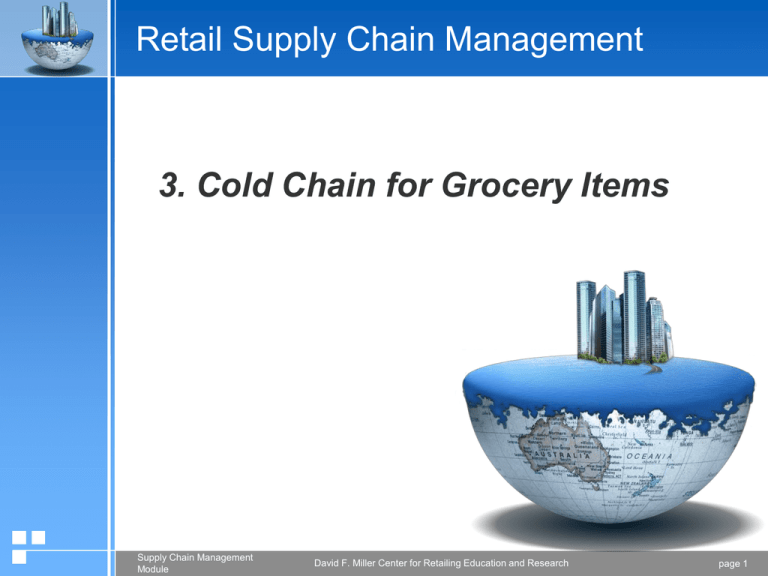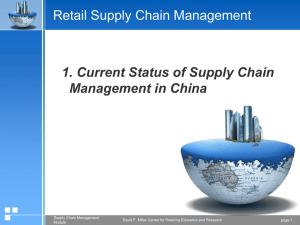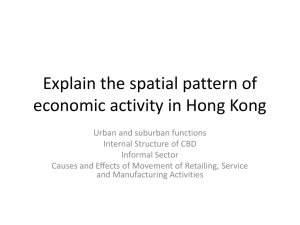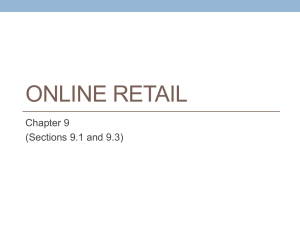Retail Supply Chain Management
advertisement

Retail Supply Chain Management 3. Cold Chain for Grocery Items Supply Chain Management Module David F. Miller Center for Retailing Education and Research page 1 Objectives Understand the importance of cold chain to retailers Learn the development and current status of cold chain in China Identify the major problems and opportunities in the development of cold chain in China Supply Chain Management Module David F. Miller Center for Retailing Education and Research page 2 Cold Chain in China1 Cold chain is a temperature-controlled supply chain. Uninterrupted series of storage and distribution activities which maintain a given temperature range. It includes transportation, load and unload, processing, storage, and selling 1: Information source: China Franchising & Chain Store Association (2009), Investigation Report on Supermarket Chains’ Fresh Food Supply Chain. Supply Chain Management Module David F. Miller Center for Retailing Education and Research page 3 Why Cold Chain? Some products needs cold or frozen storage Frozen food, milk, and tofu etc. Extend the shelf life of fresh food Prevent loss and improve food safety 20%-30% food loss occurs in transportation or storage Supply Chain Management Module David F. Miller Center for Retailing Education and Research page 4 The Relationship between Temperature and Shelf Life Product Transportati Shelf Life on (at 1 oC) Shelf Life (at 3 oC) Shelf Life (at 5 oC) Meat 2.5 days 7 days 5.5 days 4.5 days Sea Food 2.5 days 5 days 3 days 1 days Strawberry 2.5 days 10 days 7 days 3 days Salad 2.5 days 12.5 days 10.5 days 7.5 days Supply Chain Management Module David F. Miller Center for Retailing Education and Research page 5 Why Cold Chain? Increase sales and profit Jingkelong supermarket built up fresh food distribution center in 2006. The sales and gross profit of vegetable and fruits increased 50% and 5% respectively Gross profit of pork increased 4-6% Supply Chain Management Module David F. Miller Center for Retailing Education and Research page 6 Supply Chain Management Module David F. Miller Center for Retailing Education and Research page 7 Cold Chain in China Overview Integrated cold chain is rare in China Cold chain breaks when unloading products for 20-30 mins Food needs cold or frozen storage 90% retailers use cold chain. Cold chain is broken in some links. Fresh agricultural products Mostly transported and sold in normal temperature. The rotting rate is 35% for fresh food; 10%-15 % for meat and fish 5% in developed country; 3% in the U.S Supply Chain Management Module David F. Miller Center for Retailing Education and Research page 8 The Sources of Food Loss Others, 14% Upload & Unload, 14% Sort & Pick, 29% Transportation, 43% Supply Chain Management Module David F. Miller Center for Retailing Education and Research page 9 Treatment for Food Loss Re-processing, 29% Loss, 57% Return, 14% Supply Chain Management Module David F. Miller Center for Retailing Education and Research page 10 Centralized vs. Store Purchasing Store Purchasing, 7% Both, 4% Centralized Purchasing, 89% Supply Chain Management Module David F. Miller Center for Retailing Education and Research page 11 Sources of Fresh Food Farmers, 16% Both, 55% Supply Chain Management Module Wholesalers, 29% David F. Miller Center for Retailing Education and Research page 12 Temperature Check Others, 3.30% Surface Temperature, 23.08% Touch and Sight, 35.16% Refrigerated Truck Temperature, 21.98% Supply Chain Management Module Center Temperature, 27.47% David F. Miller Center for Retailing Education and Research page 13 Distribution Centers of Supermarkets No Fresh Food Distribution Center, 20% Fresh Food Distribution Centers are under Construction, 15% Supply Chain Management Module Already Have Fresh Food Disbribution Center, 65% David F. Miller Center for Retailing Education and Research page 14 Distribution Center Fresh Food Distribution Center Relatively small <5,000 m2, 75% < 500 SKUs, 68% Short of high quality refrigerated warehouse Lack of functions No processing, 57% Supply Chain Management Module David F. Miller Center for Retailing Education and Research page 15 The Size of Distribution Centers 50% 45% 40% 35% 30% 25% 20% 15% 10% 5% 0% <1,000 m2 Supply Chain Management Module 1,000-5,000 m2 5,000-10,000 m2 >10,000 m2 David F. Miller Center for Retailing Education and Research page 16 Transportation Mainly use suppliers or third party for distribution. 0.3% refrigerated trucks 15% fresh food was transported using refrigerated trucks in China; 90% in the developed countries 80%-90% fruits, vegetables, meats and aquatic products are transported using normal trucks. Supply Chain Management Module David F. Miller Center for Retailing Education and Research page 17 Transportation (Cont.) 29.67% retailers own refrigerated trucks 36.26% use suppliers’ refrigerated trucks 13.19% use the third party refrigerated trucks rented by suppliers. 5.34% use the third party refrigerated trucks rented by supermarket. Supply Chain Management Module David F. Miller Center for Retailing Education and Research page 18 Business Model for Selling Vegetables and Fruits Purely Selfrunning, 37% Mainly Selfrunning, 43% Mainly Jointrunning/for Rent, 15% Purely Jointrunning/for Rent, 5% Supply Chain Management Module David F. Miller Center for Retailing Education and Research page 19 Consumers’ Preference regarding Different Retail Formats 46% 2008 44% 51% 2007 42% 28% 2005 0% 10% 20% Hypermarket Supply Chain Management Module 7% 4% 58% 30% 40% Supermarket 50% 60% 8% 70% 80% Convenience Store David F. Miller Center for Retailing Education and Research 90% 3% 3% 6% 100% Free Market page 20 Sales of Fresh Food/Total Sales >20%, 15% <10%, 40% 10%-20%, 45% Supply Chain Management Module David F. Miller Center for Retailing Education and Research page 21 Other Issues about Cold Chain in China No industry standard and regulation Management problems Low efficient in loading and unloading Supply Chain Management Module David F. Miller Center for Retailing Education and Research page 22 References Zheng, Zhigao and Xueling Yi (2006), “A Comparative Study of Sino-Foreign China Retail Inustry”, Journal of Guangdong Institute of Business Administration, 21(4), 66-69 China Supplier Research Center, 2009, A survey Report on the Survival Situation of Suppliers in China. Chinese Retail Research, 1(2), 109-131 Supply Chain Management Module David F. Miller Center for Retailing Education and Research page 23








